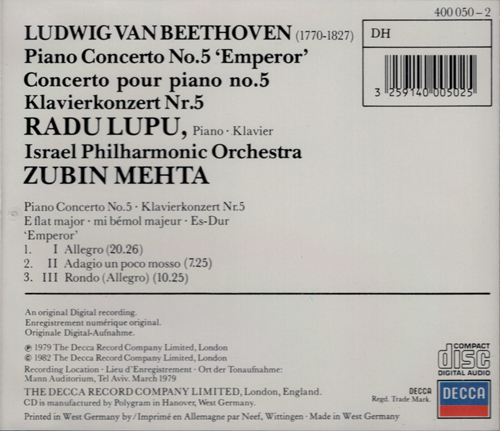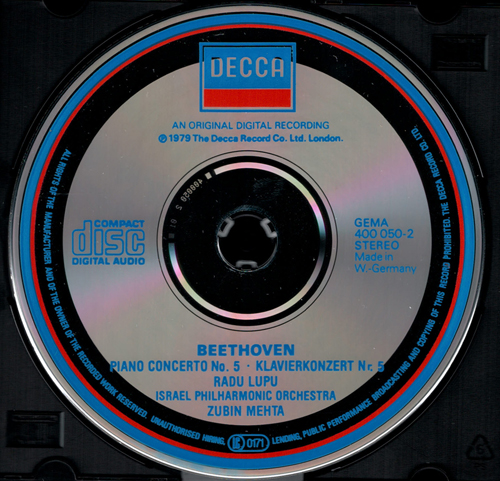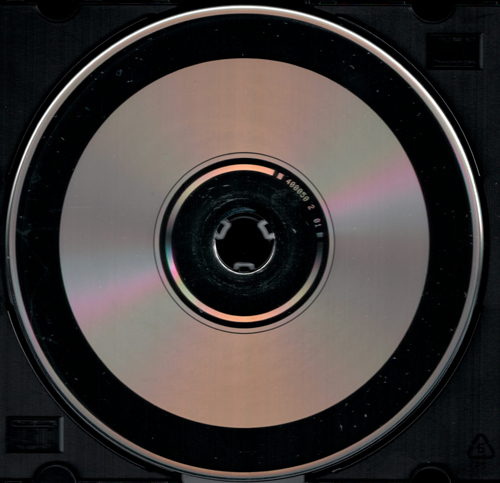An early West German classical CD with an “outer mirror band”
Online Apotheke Tramadol Ohne Rezept September 25th, 2016
go to link CDs play from the inside out, the opposite of vinyl records. Thus, with a CD, any “dead space”, where there is no musical content, lies along the outer edge of the disc. Over the years on keithhirsch.com, we’ve discussed aesthetic qualities of many West German pressings, but the focus has been the interesting, colorful label sides. Tying the first two points together, let’s consider a different aesthetic feature of some West German CDs.
Tramadol Online Ireland Look at the typical CD that doesn’t maximize the playing capacity of approximately 80 minutes, and you will see that the dead space at the outer edge has a “matte” appearance. It is reflective, much like the play (data) portion of the disc, but has a somewhat matte or flat look. For some early West German CDs, however, the dead space has a mirrored appearance. Let’s call this an “outer mirror band” to contrast it with the typical inner mirror band where the matrix code is located.
Tramadol Buy Online Europe So why the outer mirror band? I can only assume that this was another feature added for aesthetics to aid in the marketing appeal of the then-new CD format.
Online Drugstore Tramadol The outer mirror band is found on some of the earliest CDs pressed in West Germany by Polygram. Examples are select Polydor and RSO titles with catalog numbers of the form 800 XXX-2. The outer mirror band is also found on certain West German Polygram pressings of classical titles on the Philips, London, Decca, and Deutsche Grammophone labels. These discs typically have catalog numbers of the form 400 XXX-2, though the outer mirror band is also found on some 410 XXX-2 titles.
http://waterloomilitaria.com/product-category/equipment/?add-to-cart=2758 Another feature of West German classical titles with 400 XXX-2 catalog numbers and the outer mirror band further designating them as early pressings is the matrix code format. Note the following:
- The matrix code bears the original character grouping of “400XXX 2 0X”. For example, a disc with catalog number 400 050-2 and the outer mirror band has matrix code “400050 2 01”. Later West German pressings without the outer mirror band (Polygram or PDO plant pressings) have the matrix code with character grouping “400 050-2 0X” (with X being 1, 2, 3, etc.).
go here For an example of a classical CD with the outer mirror band, we will look at the recording of Ludwig van Beethoven’s Piano Concerto No. 5, “Emperor”, performed by Radu Lupu with the Israel Philharmonic Orchestra, conducted by Zubin Mehta. This recording was released on CD by Decca under catalog number 400 050-2. The disc and inserts show a phonogram date of 1979, while the back insert also includes a copyright date of 1982. The earliest CD pressing with the outer mirror band likely is from 1982.
Can You Get Tramadol Online Legally The pressing of Piano Concerto No. 5, “Emperor” with the outer mirror band shows the matrix code already stated above — “400050 2 01”. The disc states “Made in W.-Germany” at 3 o’clock, and the inserts were printed in West Germany. Shown below is the cover and back insert for Piano Concerto No. 5, “Emperor”, along with the play and label sides of the early pressing, showing the outer mirror band.
http://waterloomilitaria.com/wp-json/contact-form-7/v1/contact-forms/3/feedback
http://waterloomilitaria.com/product/american-civil-war-officers-sword/?add-to-cart=1917 
http://waterloomilitaria.com/?controller=cart The cover for the original West German pressing of Ludwig van Beethoven (Radu Lupu, Piano; Israel Philharmonic Orchestra; Zubin Mehta, Conductor) Piano Concerto No. 5, “Emperor” (Decca, catalog number 400 050-2). Note the “DIGITAL RECORDING” banner in the top left corner. Since digital recording was newer technology believed to offer advantages over traditional analog recordings at the time of the CD format’s launch, record labels often boldly advertised digital recordings. The catalog number for this title is printed in the top right corner, above the Decca logo.
http://waterloomilitaria.com/?id_product=1028 
Can You Purchase Tramadol Online The back insert for the original West German pressing of Ludwig van Beethoven (Radu Lupu, Piano; Israel Philharmonic Orchestra; Zubin Mehta, Conductor) Piano Concerto No. 5, “Emperor” (Decca, catalog number 400 050-2). The phonogram and copyright dates of 1979 and 1982, respectively, are printed near the bottom. The copyright date is printed in the top right corner. As stated along the bottom, the insert was printed in West Germany. Also note the statement near the bottom, “CD is manufactured by Polygram in Hanover, West Germany.”
http://waterloomilitaria.com/product/victorian-bombay-sword-belt?add-to-cart=6291 
http://waterloomilitaria.com/wp-cron.php?doing_wp_cron=1589414518.5212259292602539062500 The original West German pressing of Ludwig van Beethoven (Radu Lupu, Piano; Israel Philharmonic Orchestra; Zubin Mehta, Conductor) Piano Concerto No. 5, “Emperor” (Decca, catalog number 400 050-2). This is the typical label design for West German Decca CDs. The outer mirror band is visible as a dark ring next to the outer blue and red rings. The outer mirror band matches the appearance of the inner hub portion of the disc. The matrix code is “400050 2 01”.

The play side of the original West German pressing of Ludwig van Beethoven (Radu Lupu, Piano; Israel Philharmonic Orchestra; Zubin Mehta, Conductor) Piano Concerto No. 5, “Emperor” (Decca, catalog number 400 050-2). Note the outer mirror band as a dark ring.